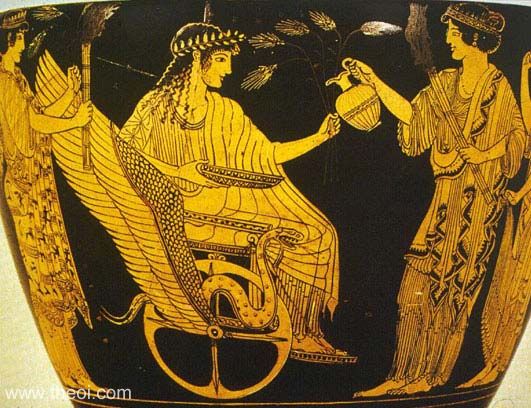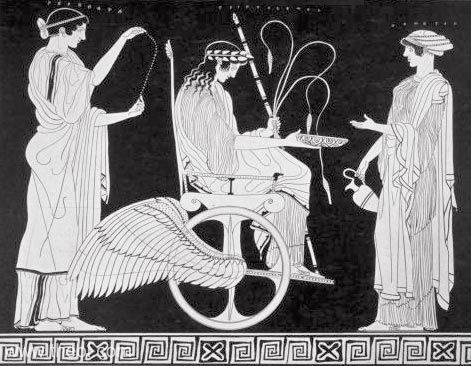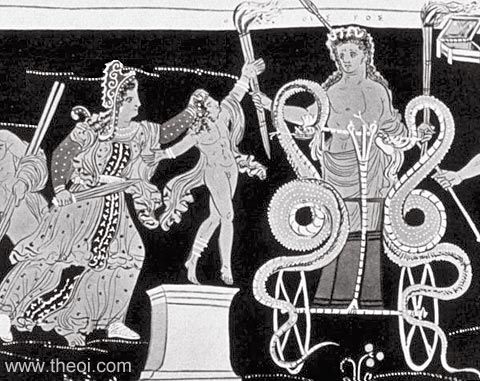DEMETER ESTATE
Greek Name
Δημητηρ
Transliteration
Dêmêtêr
Latin Spelling
Demeter
Translation
Ceres

DEMETER was the Olympian goddess of agriculture, grain and bread.
This page describes her attributes, estate, sacred plants and animals. Her usual attributes in ancient art were sheafs of grain, a crown and sceptre. Her sacred plants included grain, poppy and mint, and her animal was the serpent.
(1) TREASURES OF DEMETER
DRAKONES & CHARIOT Demeter's chariot-car was drawn by a pair of winged Drakones (serpent-like beasts). The goddess also employed these monsters as guards and attendants.
TORCHES Demeter carried a pair of flaming torches in her search for Persephone. She was often depicted in art holding one or two torches as her attribute.
SWORD OR SICKLE Demeter was called Khrysaoros (Lady of the Golden Blade) after the golden sword or sickle which she wielded.
PALACE Demeter had her home (and presumably her own palace) on Olympos.
(2) SACRED PLANTS & ANIMALS
SERPENT The serpent (a creature which represented rebirth in nature and the fertility of the earth) was the animal most sacred to Demeter. A pair of winged-serpents drew her chariot.
GECKO The gecko, found burried under rocks, was like its relative the snake, regarded as sacred to the goddess Demeter.
SWINE The pig was an animal offered to Demeter in sacrifices ensuring the fertility of the earth.
TURTLE-DOVE The turtle-dove was a bird sacred to the goddess Demeter (as well as Aphrodite).
RED-MULLET The red-mullet was a fish regarded sacred to Demeter in the cult of the Eleusinian Mysteries.
WHEAT As the goddess of agriculture, wheat was Demeter's sacred plant.
BARLEY Barley was also sacred to agricultural Demeter. The plant was used with mint and honey in a sacred drink of the Mysteries.
MINT Mint was an important component of the sacred drink of the Mysteries of Demeter.
POPPY The poppy which grew wild amongst the grain-fields was regarded as sacred to Demeter, and was worn by her priestesses.
(3) ATTENDANTS & COMPANIONS OF DEMETER
ELEUSINIAN DEMI-GODS Demeter was often depicted in the company of the Eleusinian demi-gods.
HEKATE (Hecate) A chthonian goddess who assisted Demeter in her search for Persephone. She was one of the third most important in Demeter's Eleusinian Mysteries.
IAKKHOS (Iacchus) A god of the Eleusinian Mysteries. He was the leader of the Eleusinian procession, and a personification of the ritual cry "iakhe".
PERSEPHONE The goddess of the underworld and spring growth. She spent the seasons of spring and summer in the company of her mother Demeter, but wintered in the land of Haides.
PLOUTOS (Plutus) The god of agricultural wealth was a son and close companion of Demeter. He was depicted holding the cornucopia (a horn overflowing with the fruits of the earth).
CLASSICAL LITERATURE QUOTES
DRAGON-SERPENTS & CHARIOT OF DEMETER

Hesiod, Catalogues of Women Fragment 77 (from Strabo 9. 1. 9) (trans. Evelyn-White)
(Greek epic C8th or 7th B.C.) :
"And it is from the hero [Kykhreus] that the serpent Kykhreides took its name--the serpent which, according
to Hesiod, was fostered by Kychreus [on Salamis] and driven out by Eurylokhos because it was damaging the
island, and was welcomed to Eleusis by Demeter and made her attendant."
Orphic Hymn 40 to Demeter (trans. Taylor) (Greek hymns C3rd B.C. to 2nd A.D.)
:
"A car with Drakones yoked 'tis thine [Demeter's] to guide, and, orgies singing, round thy throne to
ride."
Pseudo-Hyginus, Astronomica 2. 14 (trans. Grant) (Roman mythographer C2nd A.D.)
:
"When Ceres [Demeter] was distributing her bounties to men, she bade Triptolemus . . . go around to all the
nations and distribute grain . . . He went in a dragon car, and is said to have been the first to use one wheel,
so as not to be delayed in his journey. When he came to the king of the Getae . . . at the order of Carnabon one
dragon was killed, so that Tiptolemus might not hope his dragon car could save him when he realized an ambush
was being prepared. But Ceres is said to have come there, and restored the stolen chariot to the youth,
substituting another dragon."
Ovid, Metamorphoses 5. 502 ff (trans. Melville) (Roman epic C1st B.C. to C1st A.D.)
:
"She [Demeter] soared borne in her chariot, to the sky's bright realms and stood, with clouded face and
hair let loose, indignant before Jove [Zeus]."
Ovid, Metamorphoses 5. 643 ff :
"Bounteous Ceres [Demeter] yoked her Angues Gemini (Serpent-Pair) to her chariot, and fixed the curbing
bits and made her way between the earth and sky to Tritonia's city [Athens], and brought the chariot to
Triptolemus, and gave him seed and bade him scatter it [throughout the earth, teaching mankind the practise of
agriculture]. Partly in virgin land and part in fields long fallow . . . then [after he had finished his task
she] bade the youth of Mopsosius [Triptolemos] drive her pair of Iugales Sacri (Sacred Serpents) homeward
through the air."
Ovid, Metamorphoses 8. 782 ff :
"She [Demeter] charged a Numinis Montes (Mountain Sprite), a rustic Oreas [Oread nymph], to take her
message . . . She gave the chariot; riding through the air the Oreas reached Scythia; on a peak of granite men
call Caucasos she unyoked the Serpentes . . . the Nympha gave her the goddess' orders and hardly waiting . . .
seized the reins and soaring high she drove the Dracones back to Haemonia."
Ovid, Fasti 4. 495 ff (trans.Boyle) (Roman poetry C1st B.C. to C1st A.D.)
:
"There is a cave, rough-formed of corroded pumice [on Mt Aitna in Sicily], a place neither man nor beast
may enter [being sacred to Demeter]. When she [Demeter in search of Persephone] comes here, she brides and
hitches Serpents to her chariot, and roams the sea, dry."
Apuleius, The Golden Ass 6. 2 ff (trans. Walsh) (Roman novel C2nd A.D.) :
"The winged courses of your [Demeter's] attendant Dracones."
Nonnus, Dionysiaca 5. 562 ff (trans. Rouse) (Greek epic C5th A.D.) :
"Then beside the Drakon-manger [by her home on Olympos] she [Demeter] balanced the curved yoke over the two
necks of the monsters, and fastened the untamed crawlers with the yokestrap, pressing their jaws about the
crooktooth bit. So goldenbrown Deo in that grim car conveyed her girl [Persephone] hidden in a black veil of
cloud. Boreas roared like thunder against the passage of the wagon, but she whistled him down with her
monster-driving whip, guiding the light wings of the quick drakones as they sped horselike along the course of
the wind through the sky . . .
She alighted among the Pelorian cliffs of Threepeak Sikelia (Sicily) . . . [and] saw a neighbouring grotto like
a lofty hall crowned and concealed by a roof of stone . . . The goddess passed through the dark hall, and
concealed her daughter well-secured in this hollow rock. Then she loosed the Drakones from the winged car; one
she placed by the jutting rock on the right of the door, one on the left beside the stone-pointed barrier of the
entry, to protect Persephoneia unseen . . .
Ah, maiden Persephoneia! You could not find how to escape your mating! No, a drakon was your mate, when Zeus
changed his face and came, rolling in many a loving coil through the dark to the corner of the maiden's chamber,
and shaking his hairy chaps: he lulled to sleep as he crept the eyes of those creatures of his own shape who
guarded the door."
TORCHES OF DEMETER

Homeric Hymn 2 to Demeter 48 ff (trans. Evelyn-White) (Greek epic C7th or 6th B.C.)
:
"Then for nine days queenly Deo wandered over the earth with flaming torches in her hands [in search of her
daughter Persephone]."
Diodorus Siculus, Library of History 5. 4. 3 (trans. Oldfather) (Greek historian C1st
B.C.) :
"After the Rape of Kore, the myth goes on to recount, Demeter, being unable to find her daughter, kindled
torches in the craters of Mt Aitna and visited many parts of the inhabited world."
Ovid, Metamorphoses 5. 354 ff (trans. Melville) (Roman epic C1st B.C. to C1st A.D.)
:
"Ceres [Demeter] sought her child vainly in every land . . . She lit pine-torches, one in either hand, at
Aetna's fires, and through the frosty dark bore them unsleeping."
Statius, Thebaid 12. 270 ff (trans. Mozley) (Roman epic C1st A.D.) :
"The bereaved Ceres [Demeter] lighted her torch and from Aetna's rocks cast the shifting glare of the
mighty flame here over Sicily, there over Ausonia, as she followed the traces of the dark ravisher
[Haides]."
GOLDEN BLADE OF DEMETER
One of the epithets commonly applied to Demeter was Khrysaoros or Lady of the Golden Sword Blade. She was depicted in scenes of the Gigantomachia (War of the Giants) wielding a sword, which may have been the golden blade; or the blade might instead be a golden sickle which she used to harvest the first crops of wheat.
Some say she found the scythe that Kronos used used to castrate his father Ouranos on the island of Sicily, and employed this in the first harvest of the grain.
PALACE OF DEMETER
Demeter is described as dwelling on Olympos, where she presumably had her own palace.
Homeric Hymn 2 to Demeter 483 ff (trans. Evelyn-White) (Greek epic C7th or 6th B.C.)
:
"They [Demeter and Persephone] went to Olympos to the gathering of the other gods. And there they dwell
beside Zeus who delights in thunder, awful and reverend goddesses."
SACRED PLANTS & FLOWERS
I. WHEAT (Greek pyros)
As the goddess of grain, wheat was naturally regarded as her most sacred plant.
See Demeter Goddess of Agriculture and Grain
II. POPPY (Greek mekon)
The poppy was sacred to Demeter as it is a flower commonly found growing amongst the grain of the wheat-fields.
Callimachus, Hymn 6 to Demeter 42 ff (trans. Mair) (Greek poet C3rd B.C.)
:
"Nikippe, whom the city had appointed to be her [Demeter's] public priestess, and in her hand she grasped
her fillets and her poppy, and from her shoulder hung her key [the temple key of the priestess]."
Virgil, Georgics 1. 208 ff (trans. Fairclough) (Roman bucolic C1st B.C.) :
"When the Balance [Libra] makes the hours of daytime and sleep equal [in autumn], and now parts the world
in twain . . . then is the time to hide in the ground your crop of flax and the poppy of Ceres [Demeter]."
[N.B. Poppies and flax were apparently planted to revitalise the soil in the crop rotations.]
For MYTHS of Demeter and the poppy see Demeter Loves: Mecon
III. BARLEY & MINT (Greek krithe & minthe)
Homeric Hymn 2 to Demeter 205 ff (trans. Evelyn-White) (Greek epic C7th or 6th B.C.)
:
"Then Metaneira [Queen of Eleusis] filled a cup with sweet wine and offered it to her [Demeter]; but she
refused it, for she said it was not lawful for her to drink red wine, but bade them mix meal and water with soft
mint and give her to drink. And Metaneira mixed the draught and gave it to the goddess as she bade. So the great
queen Deo received it to observe the sacrament."
For MYTHS of Demeter and the mint plant see Demeter Wrath: Minthe
SACRED BIRDS & ANIMALS

I. SERPENT (Greek drakon)
See the Dragon-Serpents of Demeter (this page)
II. SWINE (Greek hus)
Pigs were offered as a sacrifice to Demeter to ensure crop fertility. They were connected with the goddess in a myth of the Eleusinian Mysteries.
III. TURTLE-DOVE (Greek trygon)
Aelian, On Animals 10. 33 (trans. Schofield) (Greek natural history C2nd to 3rd A.D.)
:
"White Turtle-doves are often to be seen. These, they say, are sacred to Aphrodite and Demeter."
IV. RED MULLET
Aelian, On Animals 9. 51 (trans. Schofield) (Greek natural history C2nd to 3rd A.D.)
:
"At Eleusis it [the Red Mullet] is held in honour by the initiated, and of this honour two accounts are
given. Some say, it is because it gives birth three times in a year; others, because it eats the Sea-Hare, which
is deadly to man."
V. GECKO (Greek askalabos)
The gecko, which made its home under rocks, was like its cousin the serpent, held as sacred to the earth-goddess Demeter.
For MYTHS of Demeter and gecko see Demeter Wrath: Ascalabus
SOURCES
GREEK
- Hesiod, Catalogues of Women Fragments - Greek Epic C8th - 7th B.C.
- The Homeric Hymns - Greek Epic C8th - 4th B.C.
- Callimachus, Hymns - Greek Poetry C3rd B.C.
- Diodorus Siculus, The Library of History - Greek History C1st B.C.
- Pausanias, Description of Greece - Greek Travelogue C2nd A.D.
- The Orphic Hymns - Greek Hymns C3rd B.C. - C2nd A.D.
- Aelian, On Animals - Greek Natural History C2nd - 3rd A.D.
- Nonnus, Dionysiaca - Greek Epic C5th A.D.
ROMAN
- Ovid, Metamorphoses - Latin Epic C1st B.C. - C1st A.D.
- Ovid, Fasti - Latin Poetry C1st B.C. - C1st A.D.
- Virgil, Georgics - Latin Bucolic C1st B.C.
- Statius, Thebaid - Latin Epic C1st A.D.
- Apuleius, The Golden Ass - Latin Novel C2nd A.D.
BIBLIOGRAPHY
A complete bibliography of the translations quoted on this page.